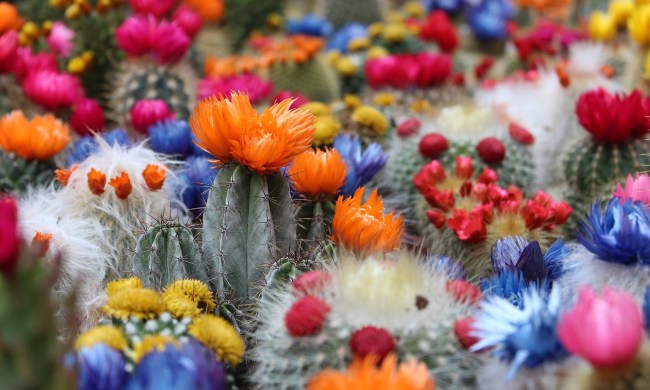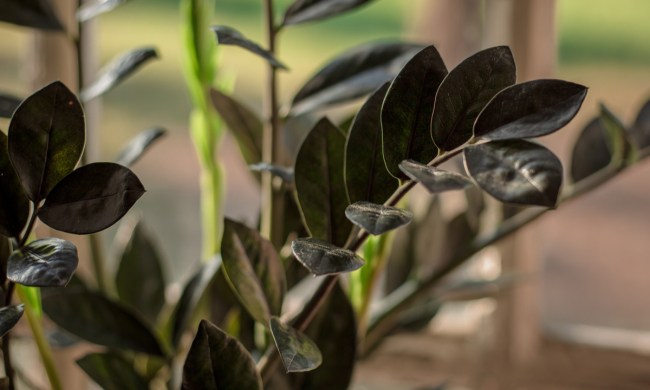Casually browse lists of houseplants that are nearly impossible to kill, and you’ll probably find the ponytail palm next to your hardy pothos and philodendron plants. Featuring arching leaves and an onion-like base, the ponytail palm (Beaucarnea recurvata) is a plant that’s as easy to find as it is to maintain. If you come across the ponytail palm at a grocery store or nursery, there’s no need to think twice about picking it up. Adding this low-maintenance plant to your houseplant collection is a great way to liven up practically any room. If you want to start growing a ponytail palm, just follow this simple ponytail palm care guide!
What is the ponytail palm?

Also known as an elephant foot tree or bottle palm, the ponytail palm features a thick trunk with curled, grass-like leaves protruding from the top. If you want something low maintenance, we’ve got good news: the ponytail palm is actually an easy-care succulent, not a real (and finicky) palm — it is, in fact, native to semi-desert areas of southeast Mexico. Still, you’ll get tropical vibes without needing to commit too much space or energy toward proper upkeep.
As a houseplant, the plant stays relatively small and can be found in four- to six-inch nursery pots because it doesn’t grow fast — you might come across indoor varieties that grow anywhere between one to six feet tall. That said, an older ponytail palm can grow up to 30 feet tall and nine to 12 feet wide in its natural habitat. Feathery, fluffy flowers sometimes grow on ponytail palms, but they are rare in houseplants.
How do you care for a ponytail palm?

Light, temperature, and humidity
When it comes to its surrounding environment, the ponytail palm appreciates a bright, warm environment. If you’re keeping a ponytail palm as an indoor plant, supply it with as much light as possible by leaving it next to a south-facing window. Outdoors, this common plant can thrive in full sun. It’s usually hardy in zones 9 through 12, preferring temperatures above 50°F. There’s no need to mist it or use a humidifier next to it, as it can tolerate low humidity.
Watering
When it comes to watering, this statement plant doesn’t need all that much water and can tolerate a bout of neglect. Its thick, bulb-like base actually stores water. When you water a ponytail plant, water it thoroughly and wait for the soil to dry before you water it again. Excess soil moisture can cause root rot, so you want to be prudent about watering, especially if you keep your plant indoors.
While it is drought tolerant, the ponytail palm can experience browning tips if you let it dry out for too long. If you notice browning tips and dry soil, cut off the crispy bits and give your plant a good drink of water. Brown tips may also be due to too much fertilizer or hard water. You can try thoroughly washing the soil if you suspect the former and using filtered water to address the latter.
Soil needs
You want to give your ponytail palm plant relatively fast-draining soil, such as a cactus potting mix with sand and perlite. You won’t really need to fortify your soil all that much. The ponytail palm plant isn’t a heavy feeder, so you can simply use a slow-release fertilizer to give it nutrients during the growing season. You also don’t need to repot it frequently. A once-a-year repotting is typical, but you could put off repotting to an every three-year cadence if you’re okay with a smaller plant.
Pest control
The ponytail palm is relatively resilient to pest issues, but you may have a bug issue or two. One common problem is fungus gnats. These flying critters are typically harmless but pesky; still, they can feed on the roots and cause problems. Fungus gnats are usually drawn to overwatered soil with fungi and organic matter, so start treating your plant by cutting back on watering. You can use a yellow sticky trap or vinegar solution to reduce an infestation. Other potential pests include scale and mealybugs, which may be treated with rubbing alcohol or neem oil. (Check out this guide on pest control for the best solution.)
How do you propagate a ponytail palm?

It’s really easiest to buy a new ponytail palm plant instead of propagating one, but that doesn’t mean it’s impossible to grow one yourself. You can usually propagate a ponytail palm by taking an offshoot from the side and potting it up. The tricky part is that the offshoots have very shallow roots, if any, so you may need to supplement them with rooting hormone.
You can also grow a new ponytail palm by seed, but it’ll take a while to see any results because this plant is a slow grower. Since indoor plants seldom flower, you may find it difficult to procure ponytail palm seeds.
Are ponytail palms safe for pets?

Ponytail palms are considered safe and nontoxic for pets and people. This is great news if you have pets that enjoy chewing on leaves, although your ponytail palm might not be thrilled about it. The long, dangling leaves are particularly attractive to cats, who might enjoy playing with them like they would string or ribbons. Your ponytail palm is hardy enough to withstand some of this, but if you’re concerned that your pets might do too much damage, you should take steps to keep your ponytail palm out of reach.
While a ponytail palm isn’t completely killproof by virtue of being a living organism, it’s a pretty hardy houseplant. Great for beginners, it tolerates drought and hardly ever falls prey to pests. Give it ample sunlight and the occasional repotting, and you’ll find that the ponytail palm plant will stay lush and fabulous.




